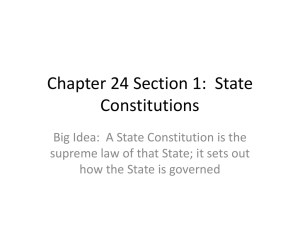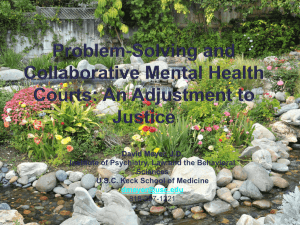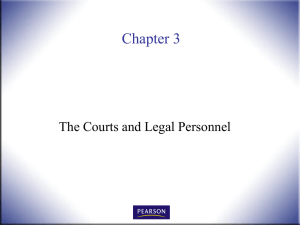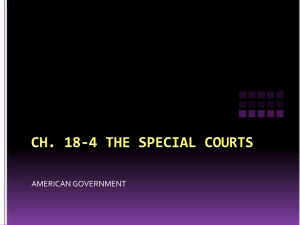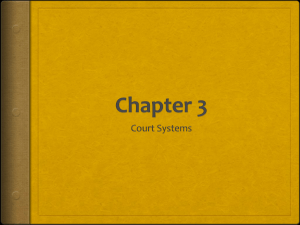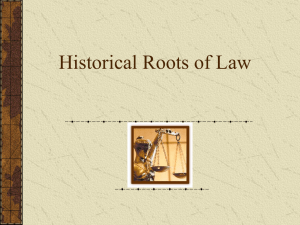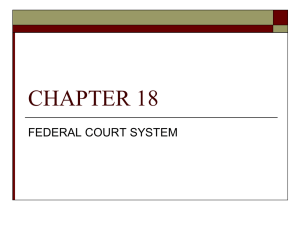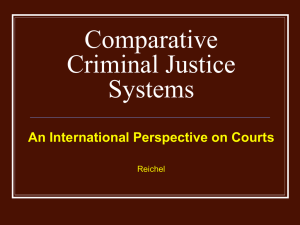Chapter 8 State Government - Waverly
advertisement
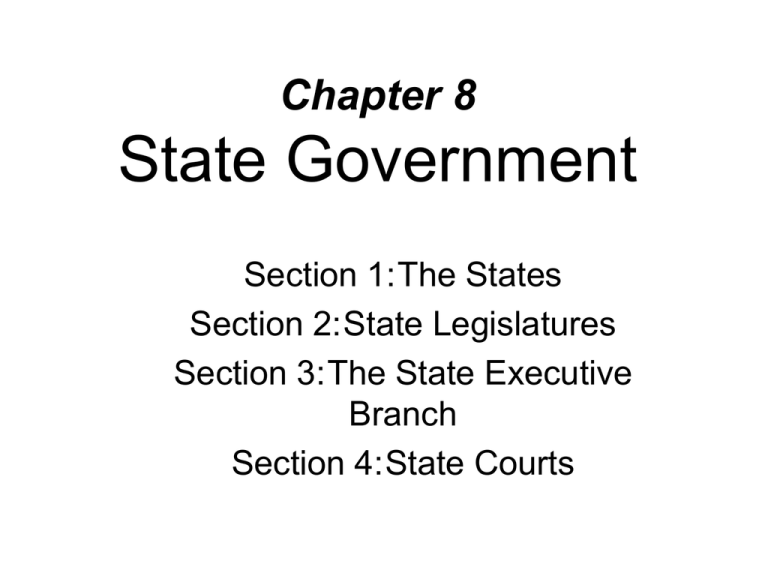
Chapter 8 State Government Section 1:The States Section 2:State Legislatures Section 3:The State Executive Branch Section 4:State Courts Section 1: The States The Main Idea In the United States, all 50 independent states fit together to form one country. The federal system allows state governments to serve the needs of the their citizens while cooperating as a united country. Reading Focus • What powers do state governments have? • How do states work together with other states and with the national government in our federal system? State Government [04:01] Section 1: The States State Powers • Election oversight • Education • Police protection • Public building programs • Health and safety • Highways Concurrent powers, like taxation, are exercised by both state and federal governments. Section 1: The States Components of a state constitution: • Preamble—states the ideals of the government • Bill of rights—list of rights guaranteed to citizens • Outline of government organization—duties of the government’s branches are spelled out • Provisions for elections • Provisions for managing state affairs, such as education, law and order, highways, and taxation • Methods of amending the state’s constitution and list of approved amendments Section 1: The States Cooperation of states with each other and the federal government: • The full faith and credit clause of the U.S. Constitution ensures states will respect court decisions of other states. • Fugitives from one state are subject to extradition if found in another state. • States work together to reduce pollution and maintain mutual public interests. Section 1: The States Cooperation of states with each other and the federal government: (continued) • The U.S. Constitution guarantees a “republican government” to each state. • The federal government must help put down “domestic violence” in the states. • Governments work together to conserve resources, assist the unemployed, build highways, and offer job training. The Powers of Government in a Federal System [03:58] SECTION 1 Question: What types of powers are reserved for the states? Powers Reserved for the States State concurrent Federal Section 2: State Legislatures The Main Idea The process of passing state laws is similar to the process used in the U.S. Congress. In some states, citizens can take a direct role in making the state's laws. Reading Focus • How are state legislatures organized to equally represent the citizens of the their state? • How are state laws passed? • How do citizens participate in making state laws? Section 2: State Legislatures Populations in state election districts: • 1964—Reynolds v. Sims: all state election districts must be as equal as possible • Equally populated districts ensure the principle of “one person, one vote.” Section 2: State Legislatures Many states require similar qualifications and terms of office for state legislators: • Must be U.S. citizens and residents of the district they represent • Senators must be at least 25 years of age, and representatives must be at least 21. • Two- to four-year terms • Salaries and benefits tend to be low. Section 2: State Legislatures Choosing presiding officers and carrying out legislation: • Either the lieutenant governor or a selected official presides over the Senate. • Speakers are chosen in the lower houses. • Committees are appointed. • Seniority determines many of the appointments. Section 2: State Legislatures Choosing presiding officers and carrying out legislation: (continued) • State bills follow a path similar to that of federal bills before they can become laws. • Some states require referendums before certain bills become laws. SECTION 2 Question: What are the qualifications and terms of office for a state legislator? HELP WANTED LEGISLATOR Job qualifications include: Terms of Office: State Government [03:49] Section 3: The State Executive Branch The Main Idea • A state’s executive branch carries out laws made by the state’s legislative branch. Governors are the chief executives of state government. Reading Focus • Who is the state’s chief executive, and what are his or her powers and duties? • Who are the other officials of state executive branches? Section 3: The State Executive Branch Most governors • Must be U.S. citizens who have lived in the state for a certain number of years. • Must be at least 30 years old. • Serve four-year terms with limits of one to two terms. Section 3: The State Executive Branch Duties and powers of governors include • Proposing laws and programs to the legislature; approving or vetoing bills. • Developing state budgets. • Controlling state police and militia. • Appointing officials and supervising executive branch. Section 3: The State Executive Branch Other officials of the state executive branch, in most states: • Lieutenant governor—succeeds governor; presides over the Senate • Secretary of state—keeps state records and supervises elections • Attorney general—in charge of legal business • State treasurer—supervises all state funds Section 3: The State Executive Branch Other officials of the state executive branch, in most states: (continued) • State auditor (comptroller)—supervises the state’s financial records • Superintendent of public instruction— governs local school districts and distributes state funds Section 3: The State Executive Branch State Executive Agencies and Officials • Help the governor carry out the laws • Have specific areas of responsibility such as agriculture, justice, labor, public safety, public works, or transportation • Officials of agencies are usually appointed by the governor. • Some jobs are filled through patronage. SECTION 3 Question: What are the powers and duties of the governor? 1. Chief Legislator Powers and Duties of the Governor 2. Chief Executive 3. Political Party Leader 4. Other Powers Section 4: State Courts The Main Idea State court systems include lower courts, general trial courts, appeals courts, and state supreme courts. Reading Focus • What kinds of cases do state courts handle? • How is the state court system organized? • How are state judges selected? Section 4: State Courts State courts handle • Criminal cases, which deal with violations of the law that harm individuals or society. • Civil cases, which deal with disputes between individuals or business and generally involve money or property. Section 4: State Courts Four types of state courts and their responsibilities: • Lower courts—handle minor civil cases and misdemeanors; traffic cases, family-relations cases, and small claims • General trial courts—handle major criminal and civil cases Section 4: State Courts Four types of state courts and their responsibilities: (continued) • Appeals courts—handle appealed cases from the lower courts • State supreme court—handles appealed cases from the appeals court Section 4: State Courts Overcrowding in the courts causes problems. • Calendars are often a year or more behind. • People wait years for settlements. • Jails are overcrowded with accused persons awaiting trial. • Crowding thwarts constitutional guarantee of a speedy trial. SECTION 4 Question: What are the responsibilities of each of the four types of state courts? State Courts General Trial Courts: These courts hear major civil and criminal cases. Most involve a jury with a judge presiding. Lower Courts: These courts hear minor cases, including misdemeanors and civil cases involving small amounts of money. They may also handle traffic violations, family disputes, and juvenile cases. Appeals Courts: State Supreme Courts: These courts are the highest court in most states hearing cases on appeal. These courts hear cases on appeal, deciding if the lower court handled the trial properly and gave the accused the rights guaranteed under the Constitution. Chapter 8 Wrap-Up 1. What is the term for the powers granted to state governments, and what are some examples? 2. How are the rules of state governments organized, and under what rule did they agree to cooperate with each other? 3. What conditions must be met in order for someone to serve as a state lawmaker? 4. How can citizens take direct action in legislation and state government? 5. Who heads the state executive branch, and what does the job require? 6. Who helps the governor run the state government? 7. What types of courts exist in most states, and what does each do? 8. How does the appeals process work?

